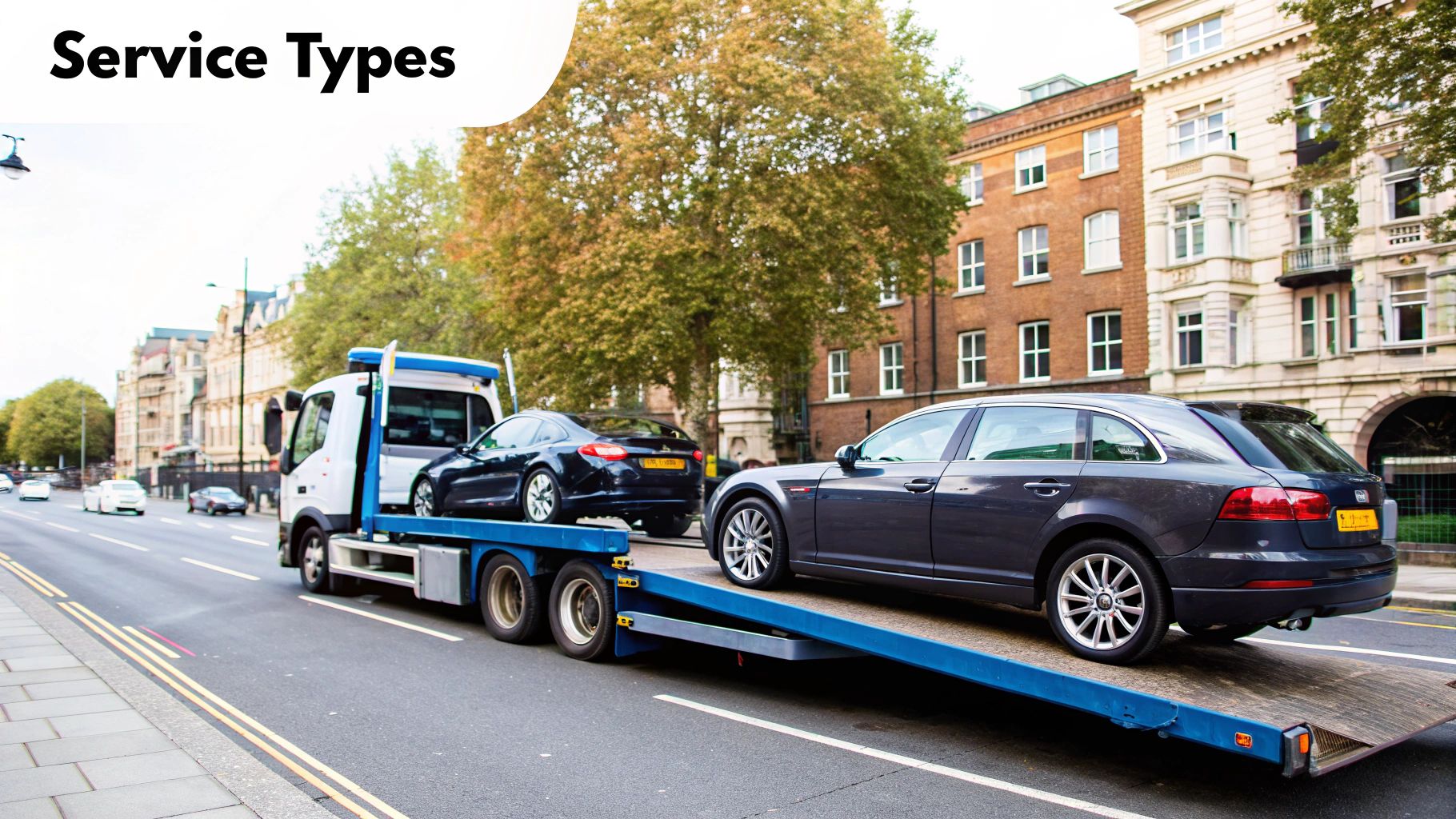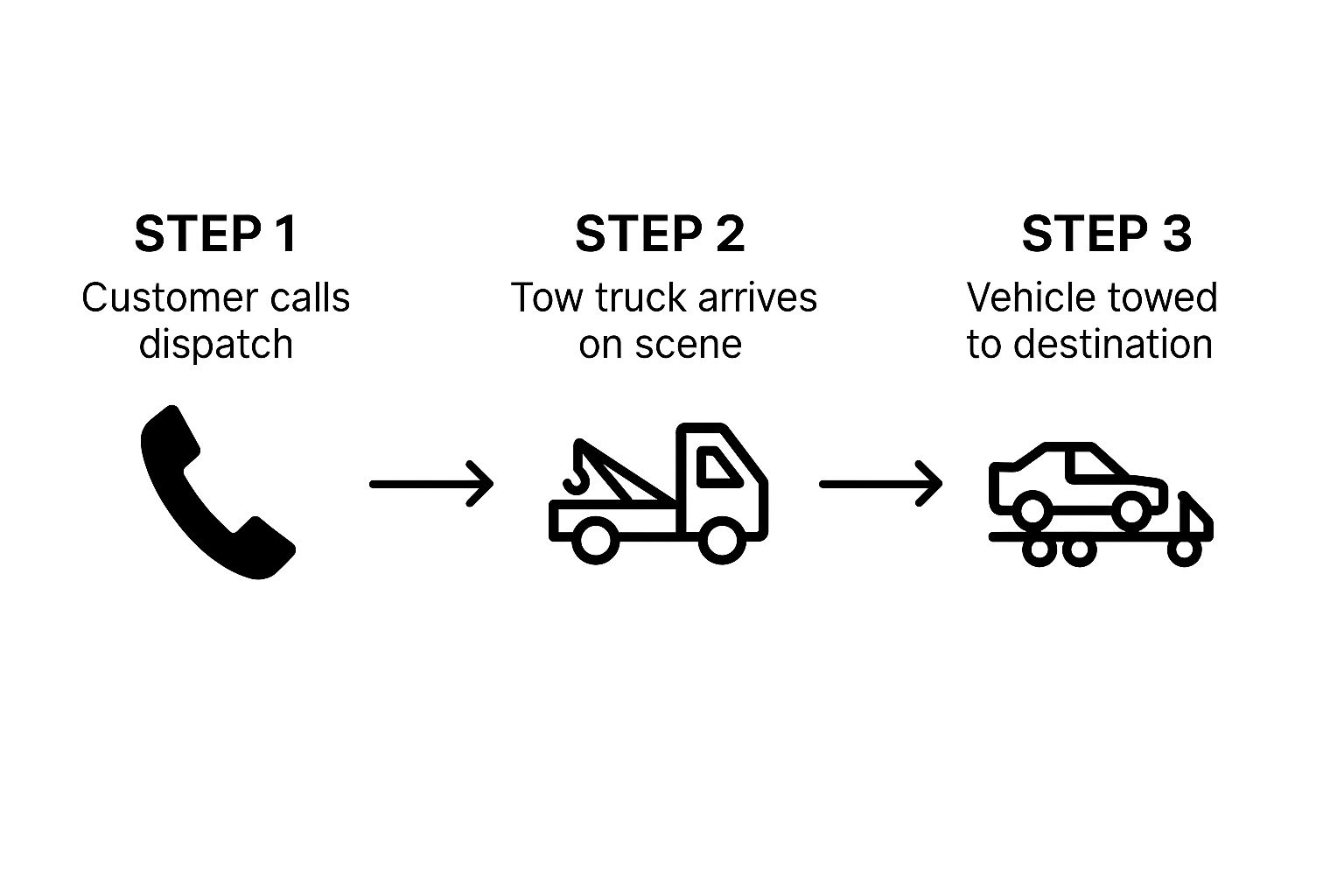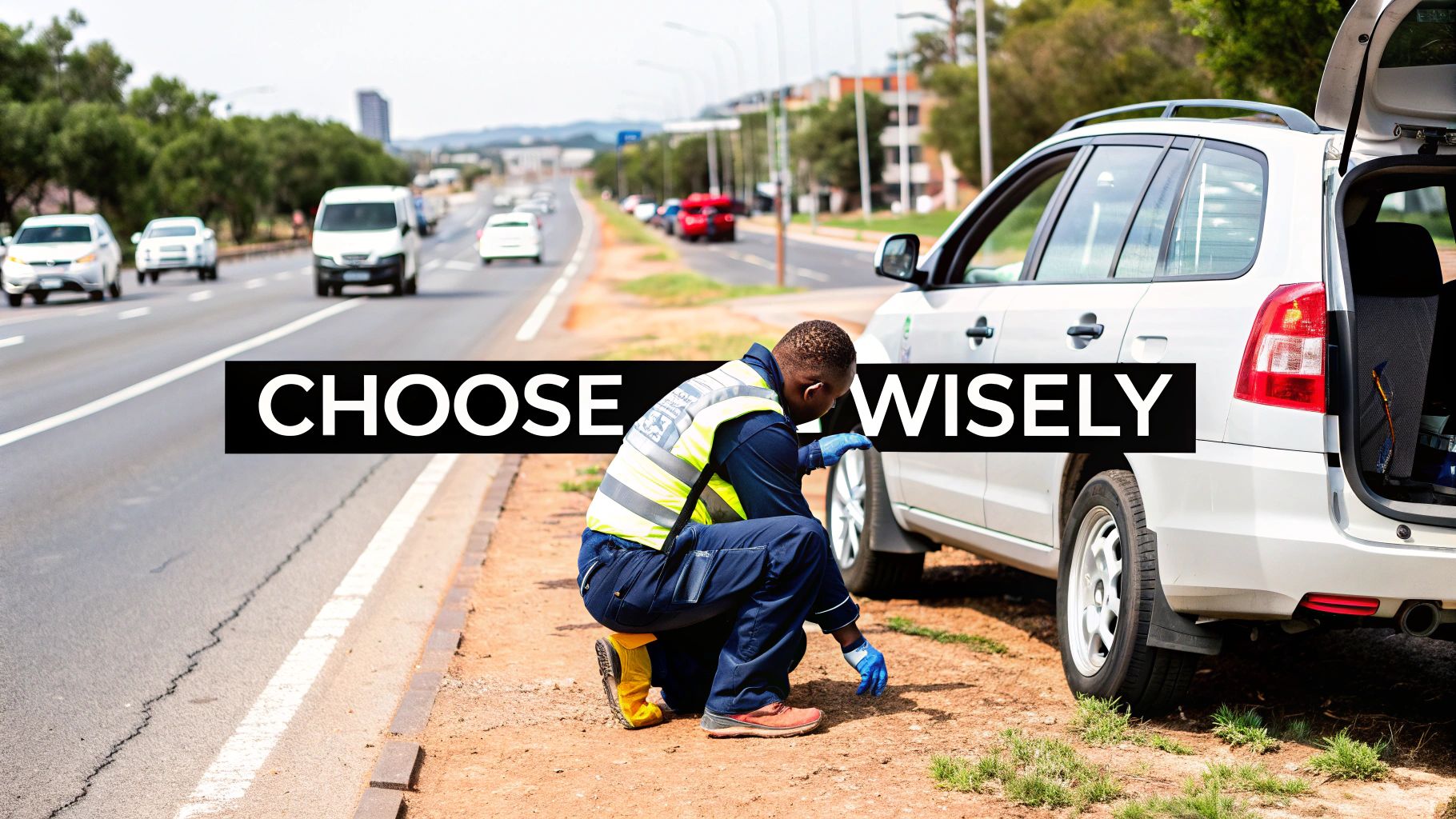Getting stranded in London is a nightmare, but finding a reliable towing service in london shouldn’t make things worse. The secret is to ditch the old-school phone directories and long-winded searches. Modern tools connect you with vetted, local professionals in minutes, giving you clear pricing and a trustworthy response when you need it most.
Finding Help Fast When You Are Stranded in London
There’s nothing quite like the sinking feeling of your vehicle breaking down on one of London’s packed streets. For daily commuters, it’s a massive inconvenience. For professional drivers—from taxi operators in Manchester to delivery fleets across England—it’s a financial disaster waiting to happen.
The usual headaches are all too familiar: vague wait times, confusing price quotes, and the gamble of finding a trustworthy provider in the maze of a city’s road network. A simple breakdown in London or Birmingham can quickly escalate into a full-blown crisis.
But the way we get help is finally catching up. The old routine of frantically scrolling through search results and making endless calls is being replaced by much smarter, app-based solutions that serve the whole of the UK.
The Modern Approach to Roadside Assistance
Let’s be clear: roadside assistance in the UK is a huge industry, and towing is its biggest part. The sector is set to grow, especially with more cars on the road and the unique traffic challenges in cities like London, Manchester, and Liverpool.
This is where platforms like the Crisfix app come in. They’re built specifically to solve these problems by putting you in direct contact with available, pre-vetted towing professionals right from your phone.
For anyone driving for a living in London, downtime is the enemy. Waiting hours for a tow truck isn’t just frustrating; for a taxi driver or a courier, it’s lost earnings and a blow to their reputation. This is a challenge faced by professional drivers across England.
This move to app-based platforms gives you a clear edge. Instead of hoping for the best, you get access to a network of approved providers, often with upfront pricing and the ability to track your truck’s arrival in real-time. If you’re fed up with waiting around, it’s worth seeing how to call a tow truck without waiting for hours to understand how much better the new way is.
To really see the difference, let’s compare the old way versus the new.
Comparing London Towing Service Options
When you’re stuck, every minute counts. The difference between calling a random number from a search result and using a dedicated app can be massive. Here’s a quick breakdown of how traditional services stack up against modern platforms like Crisfix.
| Feature | Traditional Towing Service | App-Based Platform (e.g., Crisfix) |
|---|---|---|
| Booking Process | Phone calls to dispatchers, often with long hold times and back-and-forth explanations. | Instant booking through a mobile app in just a few taps. Simple and direct. |
| Price Transparency | Vague quotes over the phone, with the constant risk of hidden fees once the job is done. | Upfront, transparent pricing shown before you confirm the booking. No surprises. |
| Wait Time | “We’ll be there soon” is the best you get. Estimated arrival times are often inaccurate. | Real-time GPS tracking of the dispatched tow truck for a precise ETA you can trust. |
| Provider Vetting | It’s nearly impossible to verify credentials or read reliable reviews in the middle of an emergency. | Access to a network of pre-vetted, licensed, and insured professionals with customer ratings. |
Ultimately, app-based platforms take the guesswork and stress out of a bad situation. You get control, clarity, and confidence that help is truly on the way—a far cry from the uncertainty of the old-school phone call lottery.
How to Vet UK Towing Companies Like a Pro

When you’re stuck on the side of the road, choosing the right towing company is about more than just a quick Google search. You’re under pressure, and the last thing you need is a dodgy operator. Whether you’re in central London or stranded on a motorway near Liverpool, knowing how to spot a professional, licensed, and insured provider is key.
Properly vetting a company protects your vehicle and your wallet. For a professional driver in the taxi industry, this step is absolutely non-negotiable—downtime or vehicle damage means lost income. The good news? Spotting a trustworthy operator is pretty straightforward once you know the signs.
Check Their Digital Footprint and Professionalism
First things first, take a look at their online presence. A legitimate business, whether it’s based in London or Newcastle, will have more than just a mobile number floating around online. You should be able to find a professional website or, even better, a detailed profile on a trusted service platform.
Here are a few dead giveaways of a reliable provider:
- A Physical Address: A verifiable UK business address shows they are an established, local company. If all you can find is a phone number, be wary.
- Clear Service Details: Their profile should tell you exactly what they do. Do they offer 24/7 recovery? Can they handle light commercial vehicles? Do they have flatbeds for EVs and 4x4s? Vagueness is a massive red flag.
- Genuine Customer Reviews: Scan for recent, detailed reviews that describe real-world experiences. A few negative comments are normal, but a pattern of complaints about surprise charges or unprofessional behaviour is a clear warning to steer clear.
A common trap is falling for prices that seem too good to be true. If a quote is unbelievably low or the provider is cagey about the cost breakdown, you’re likely setting yourself up for hidden fees later on. Transparency is the hallmark of a true professional.
Let’s say you’ve broken down near Birmingham. One company quotes a flat £50 without asking a single question. Another asks for your vehicle type and destination, then gives a detailed quote of £85 plus mileage. That second option is almost always the more honest and reliable choice. When you’re weighing your options, you can find out more about how a modern towing app pre-vets its entire network of professionals for you.
Look for Certifications and UK Standards
Beyond their online shopfront, it’s vital to know if the company plays by UK industry rules. You’re probably not going to ask for their paperwork on the side of a busy A-road, but their website or app profile should proudly mention their credentials.
Keep an eye out for affiliations with respected UK recovery organisations like the Association of Vehicle Recovery Operators (AVRO) or certifications such as PAS 43. These aren’t just fancy badges; they show that the operator is committed to safety, training, and professional standards. This is especially important for tricky jobs, like recovering a car from an awkward spot, ensuring they have the right gear and know-how to get it done safely anywhere in England.
Using the Crisfix App for Roadside Assistance
When your car gives up on you in the middle of a busy London street, the last thing you need is a complicated process. Forget fumbling with search engines and calling around. The Crisfix app gives you a direct, simple path to getting a towing service in London sorted in minutes. It’s designed to take all the guesswork out of the equation, from booking right through to payment.
First things first, you’ll want to download the app and set up a quick profile. This just involves entering your basic details and your vehicle information—think make, model, and registration. Getting this done beforehand means that when an emergency does strike, you’re already one step ahead.
Pinpointing Your Location and Describing the Issue
Once your profile is ready, the app uses your phone’s GPS to find your exact location instantly. This is a massive help, especially if you’re stranded in an unfamiliar part of the city and can’t describe your whereabouts over the phone. You just confirm your spot on the map, and that’s it.
Next, you tell the app what’s wrong. It gives you clear, simple options to choose from, like “flat tyre,” “engine won’t start,” or “accident recovery.” You can even add a quick note with any extra details, which helps the recovery driver show up prepared with the right gear.
This simple infographic shows just how streamlined the whole thing is.

It really boils a stressful event down into a few manageable taps on your screen.
Selecting a Provider and Tracking Their Arrival
After you’ve sent your request, the app immediately shows you a list of available, vetted recovery operators nearby. For each one, you can see their customer ratings, the services they offer, and most importantly, an upfront, transparent price quote. No hidden fees, no nasty surprises. You simply pick the provider that works for you and confirm the booking.
To give you complete peace of mind, the Crisfix app also has real-time GPS tracking. You can actually watch your tow truck making its way to you on a map, which gives you a precise and reliable ETA. That feature alone seriously cuts down on the anxiety of waiting by the roadside.
One of the handiest features is the in-app chat. It lets you communicate directly with your driver, which is perfect for giving last-minute updates—like telling them exactly where you are in a massive car park—without having to make a phone call.
The goal is to put you back in control, whether you’re a local Londoner or a fleet manager keeping an eye on vehicles in Birmingham or Manchester. The app is built to be intuitive, so you can get help quickly and confidently when it matters most.
You can learn more about how the platform works by checking out our guide on roadside assistance.
What to Expect for Towing Costs and Payments

Let’s be honest, the biggest worry when you need a tow is the final bill. Getting a straight answer on what a towing service in London or anywhere else in the UK will actually cost can feel like a guessing game. But once you understand what goes into the price, it’s a lot more straightforward.
Most towing costs aren’t random; they’re based on a few key factors. Knowing what they are helps you spot a fair quote and avoid that sinking feeling of being overcharged when you’re already stressed out.
Breaking Down the Costs
The price you see isn’t just a single flat fee. It’s almost always a combination of charges that reflect your specific situation. Think of it as a breakdown (no pun intended) of the service you’re getting.
Here’s what usually makes up your quote:
- Call-Out Fee: This is the base charge just for getting the truck dispatched to you. It covers the provider’s initial time and the cost of getting mobile.
- Mileage Charge: A big chunk of the bill often comes from a per-mile rate, calculated from where you broke down to your destination.
- Vehicle Type: It’s a lot easier to tow a little Ford Fiesta than it is to recover a big commercial van or a heavy 4×4. The bigger the vehicle, the more specialised the equipment needed, and that’s reflected in the price.
- Time and Day: This one’s a classic. Calling for a tow late at night, on a weekend, or during a bank holiday will almost certainly cost you more. It’s just down to the higher operational costs for the towing company during unsociable hours.
The number one frustration we hear about is hidden fees. That’s why reputable providers, especially those on platforms like Crisfix, give you a transparent, itemised quote before you confirm anything. It takes the anxiety right out of the equation.
Estimated Towing Costs in Major UK Cities
To give you a clearer picture, where you break down matters. A simple tow in the middle of London will often be priced differently from a motorway recovery job near Birmingham, mainly due to things like local traffic and operational demands.
Here’s an illustrative table to show you what you might expect to pay.
| Service Scenario | Estimated Cost in London | Estimated Cost in Manchester/Birmingham |
|---|---|---|
| Standard car, 5-mile tow (weekday) | £75 – £120 | £65 – £100 |
| SUV/4×4, 10-mile tow (weekday) | £90 – £150 | £80 – £130 |
| Commercial van, motorway recovery (weekend) | £150 – £250+ | £140 – £220+ |
These are just estimates, of course, but they show how the final cost can shift based on the job and the city.
Handling Payments and Paperwork
The roadside assistance industry is a huge, adaptable market in the UK. According to research from IBISWorld, its resilience comes from offering a diverse range of service options that meet modern demands.
Thankfully, paying for a tow is much simpler these days. With an app like Crisfix, the entire transaction is handled securely within the platform, so you don’t have to scramble for cash on the side of the road.
Always make sure you get a proper receipt, whether it’s digital or a physical copy. This little bit of paperwork is crucial if you need to make an insurance claim or, if you’re a taxi or fleet operator in places like London or Newcastle, log it as a business expense.
Staying Safe While Waiting for Your Tow Truck
That tense window of time between your car giving up and the recovery truck pulling up can feel like an eternity. But more importantly, it can be the most dangerous part of the whole ordeal. Whether you’re stranded on a quiet London side street or a roaring UK motorway, your safety comes first. Keeping a cool head and taking a few smart actions can make all the difference.
Your first move, without a doubt, is to make your vehicle impossible to miss. Flick on your hazard warning lights immediately. It’s the universal signal for distress, giving other drivers a crucial heads-up that there’s a problem ahead and buying them precious seconds to react.
You can see this link for Your Guide to Using a Jump Start Battery Pack article here or the here is the link for Tyre Bead Sealant: A Fleet Manager’s Guide to Maximising Uptime.
Positioning and Awareness
If you have enough momentum and it’s safe, get your car out of the live traffic flow. On a motorway, that means aiming for the hard shoulder or a lay-by. On a city street, try to duck into a side road or hug the kerb as tightly as possible. This one simple manoeuvre drastically cuts the risk of another vehicle hitting you.
But what if you’re on a ‘smart’ motorway with no hard shoulder? The situation changes completely. Official UK advice is crystal clear: stay inside your vehicle with your seatbelt fastened, keep the hazards flashing, and call 999 straight away. Do not get out of your car.
For professionals like taxi drivers or couriers zipping around London, Manchester, or Liverpool, local knowledge is a real asset. Use it to your advantage to find the safest possible spot to wait for your towing service in London.
The single biggest decision you’ll make is whether to stay in the car or get out. On a high-speed road like a motorway, it’s almost always safer to exit your vehicle from the passenger side (away from traffic) and get behind a safety barrier. Sitting in a stationary car on a live motorway is incredibly dangerous.
Preparing for the Tow Truck’s Arrival
While you’re waiting, you can get a few things in order. Having your details ready makes the handover process with the recovery driver much smoother and faster. This is especially true for professionals who need to get back in business without delay.
Just jot down a quick checklist on your phone:
- Your Precise Location: Drop a pin using your map app or look for the small marker posts on the motorway.
- Vehicle Registration: Have your number plate ready to go.
- The Problem: A quick note on what went wrong (e.g., “engine died,” “flat tyre”).
- Your Destination: The full address of the garage or wherever you need to go.
This is where an app like Crisfix really proves its worth. It uses GPS to lock onto your location, lets you type in the problem, and then shows you your recovery truck approaching in real-time. That tracking feature isn’t just a gimmick; it calms the nerves and gives you a clear ETA, so you know exactly when to expect help. For anyone stranded, from a family in Birmingham to a fleet manager overseeing vehicles across England, that kind of control is invaluable.
Your Weekly UK Towing and Taxi Industry News

For any professional in the UK’s towing and taxi industries, staying ahead of the curve isn’t just a nice-to-have—it’s what keeps your business moving. From the packed streets of London to the motorways near Liverpool, things change fast. This is your weekly briefing on the developments that actually matter to your bottom line.
Whether it’s a new regulation from Transport for London or fluctuating fuel prices hitting fleet managers in Manchester, being in the know helps you adapt and thrive. This week, we’re looking at a crucial piece of vehicle tech that’s changing the landscape.
You can see on this link an article about Roadside Assistance App UK or an article about Towing App in Crawley on here.
Industry Focus: The Rise of Small Displacement Engines in Towing
A major trend is quietly reshaping the capabilities of both cars and recovery vehicles across the UK: the rise of small-displacement turbocharged engines. For years, the industry mindset was that serious towing required a large V6 or V8. That thinking is now outdated, and it’s a critical piece of information for any UK-based fleet manager or recovery operator.
Modern 2.0-litre turbo engines are becoming commonplace, rewriting the rules on power and efficiency. This technology is a significant talking point for fleet managers and towing professionals in London, Birmingham, and beyond, as it offers a different balance of power and operational cost.
- Engineered for Torque: New turbo-fours are built for strong, low-end torque, making them surprisingly capable for many towing jobs.
- Smarter Transmissions: When paired with a modern 8-speed automatic gearbox, power delivery is both smooth and reliable under load.
- Chassis is King: A vehicle’s stability often matters more than raw horsepower. A well-balanced chassis can offer a safer tow than a bigger, clumsier vehicle, even with a smaller engine.
Real-World Performance: What Towing Professionals Need to Know
While spec sheets are one thing, real-world application is what counts for the towing industry. Day-to-day testing across England is proving that a smaller turbo engine, when correctly configured, can handle loads that were once considered V6-only territory.
Of course, fuel efficiency remains a top concern for any business, especially in the taxi industry. A small turbo may work harder and use more fuel when pulling a heavy load, but its overall economy for mixed-use driving is often far superior. That’s a massive potential win for any business running a fleet, whether you’re based in Birmingham or Newcastle.
The key takeaway for the UK towing and taxi industries is this: a vehicle’s tow rating alone doesn’t tell the full story. You must consider the entire package—wheelbase, suspension design, and tyre quality are just as critical as the horsepower number on a brochure when making fleet decisions.
As technology advances, the capabilities of our vehicles are constantly being redefined. For a towing service in London, this means building a versatile fleet capable of handling everything from a small EV to a light commercial vehicle is becoming more complex. Staying on top of these mechanical shifts is essential for making smart investments and meeting the diverse needs of customers across the UK.
Got Questions? We’ve Got Answers
When you’re stuck on the side of a busy London road, a million questions can race through your mind. It’s stressful, and the last thing you need is confusing information. Here are some of the most common queries we hear from drivers across the UK, answered simply and directly.
How Long Will I Be Waiting for a Tow Truck in London?
Honestly, it varies. In a city like London, a tow truck could get to you in 30 minutes, or it could take well over an hour. It all depends on traffic, the time of day, and where exactly you’ve broken down. This is true for other major UK cities like Manchester or Birmingham as well.
This is where an app like Crisfix really makes a difference. Instead of just giving you a vague guess, it connects you to the closest driver and shows you their real-time location on a map. No more wondering if they’re actually on their way.
Can I Get My Car Towed to My Usual Garage?
Yes, absolutely. You’re in control. Whether you’re in London, Manchester, or Liverpool, you can tell the recovery driver exactly where you want to go—be it your trusted local mechanic, your driveway at home, or any other safe spot in the UK.
Just make sure you have the full, correct address handy when you make the booking. The final cost is based on the distance from where you are to where you’re going, so accuracy helps.
Expert Tip: Always tell the operator your vehicle type when you book. A specialised vehicle might need specific gear, and getting it right the first time saves everyone a massive headache. This is vital information for any towing service in England.
What if I Drive an EV or a 4×4?
This is a really important one. If you have an electric vehicle (EV) or a four-wheel-drive (4×4), you must let the towing company know. These vehicles often need a flatbed tow truck to prevent serious damage to the electric motor or drivetrain.
Mentioning this upfront is crucial. It ensures the right UK-compliant truck is sent out immediately, protecting your car from costly repairs and getting you off the road faster. It’s a simple step that makes all the difference for drivers across the UK.
You can see this link for Your Guide to Using a Jump Start Battery Pack article here or the here is the link for Tyre Bead Sealant: A Fleet Manager’s Guide to Maximising Uptime.
When you need fast, reliable, and transparent help on the road, trust Crisfix Towing App to connect you with vetted professionals in minutes. Download the app and take the stress out of roadside assistance.
You can see on this link an article about Roadside Assistance App UK or an article about Towing App in Crawley on here.





